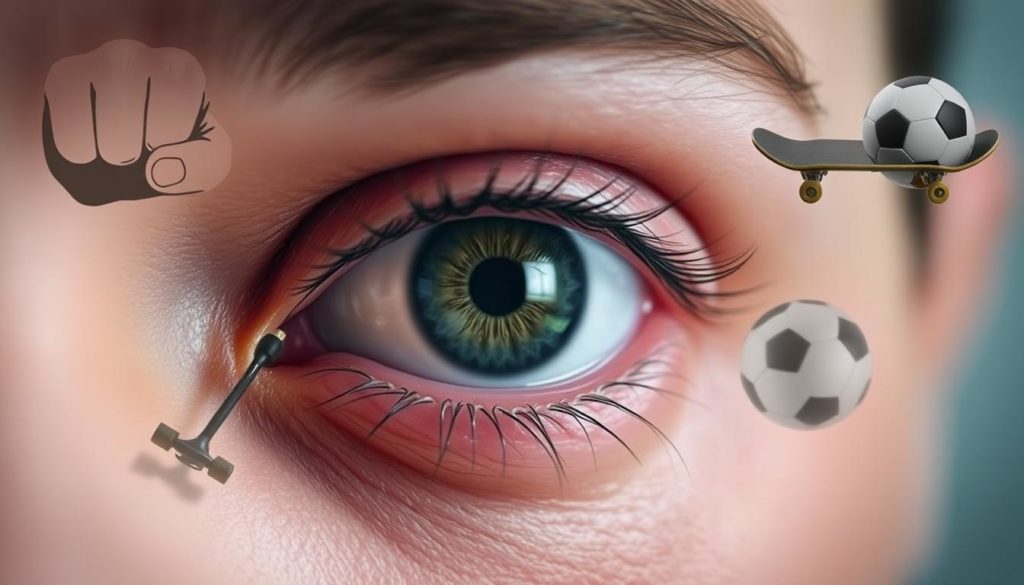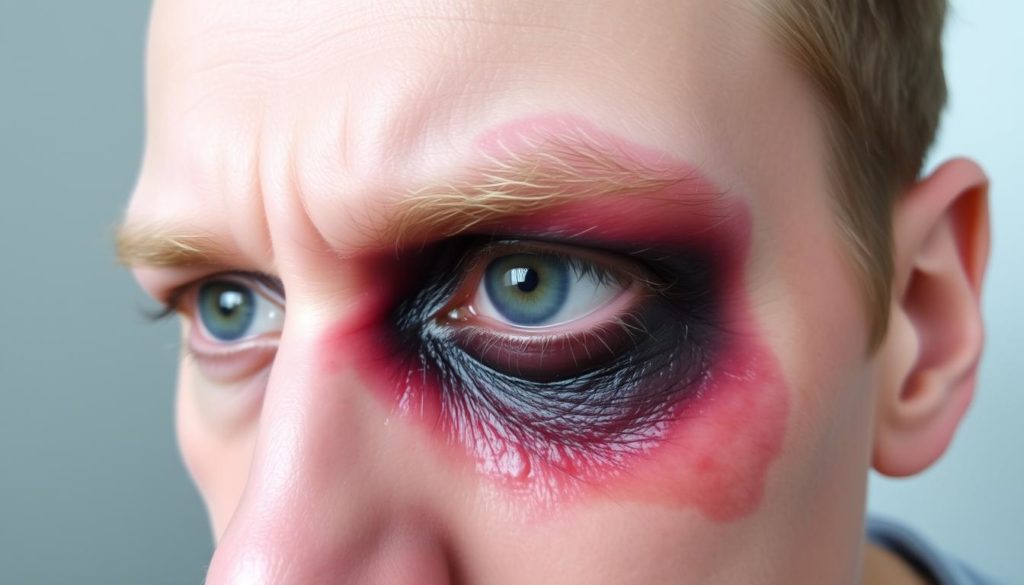About 85% of black eye cases come from hits, causing bad bruising. This injury happens a lot in sports or from falls. It can make you feel pretty bad and mess up your day. But don’t worry, we have quick and helpful ways to treat a black eye and get better fast.
A black eye, or “periorbital hematoma,” means your eye area has swelling and bruising. Quick action is key to reduce damage and heal fast. Using cold packs and keeping your head up are ways to ease your pain.
Getting a black eye from sports or just by accident is common. Knowing how to fix it quickly is important. It helps to use pain relievers from the store and to skip old, unhelpful methods like putting raw meat on it. This way, you heal faster and safer.
Keep reading to learn the best ways to treat a black eye. These tips aim to help you feel better and heal well.
Understanding What Causes a Black Eye

A black eye often comes from physical trauma. This happens when small blood vessels under the skin near the eye burst. It can happen after a minor accident or if something hits you, like a ball or fist. Knowing why these injuries happen can help prevent them and aid faster healing.
Physical Trauma
Physical trauma is a top reason for a black eye. Sports or mishaps can lead to facial injuries. Wearing safety gear during risky activities is key to avoiding these injuries.
Post-Surgery Complications
Surgery can also cause a black eye. This is especially true for face-related surgeries, like dental or cosmetic procedures. Following doctor’s advice after surgery reduces the chance of getting a black eye and helps in quicker healing.
Recognizing the Symptoms of a Black Eye

Knowing how to spot a black eye is key for proper care. At first, you might see swelling and color changes around the eye. The area changes colors, going from red to purple, and then green to yellow. This shows how the injury heals over time.
Swelling and Bruising
A black eye often starts with swelling that happens fast. This swelling comes from fluid build-up. There’s also bruising, turning deep purple or black. Knowing each stage of a black eye is important. It helps you understand how it’s healing. Using cold packs can lessen swelling and pain.
Visual Impairments
Black eyes can lead to trouble seeing. This might be slight or very bad, based on the injury. Sometimes, blood appears inside the eye, a condition known as a subconjunctival hemorrhage. Catching these early helps avoid worse problems and gets you the right treatment sooner.
| Symptom | Description |
|---|---|
| Swelling | Fluid accumulation causing puffiness around the eye |
| Bruising | Discoloration evolving through stages: red, purple, green, yellow |
| Visual Impairments | Blurriness to severe vision issues, possibly with internal bleeding |
Immediate Actions After a Black Eye Injury
Quick self-care is key when dealing with a black eye. First, you should put a cold compress on it to lessen swelling and ease the pain. Here’s what you need to do right away:
Cold Compress Application
Applying a cold compress for black eye is a top tip in the first day. Press a cold compress lightly against the mark. Do this for 15 to 20 minutes every hour. Make sure the ice or frozen pack is in a cloth to protect your skin. Don’t push too hard on the bruise. Never put ice directly on your skin. These steps quickly help reduce swelling and pain.
Elevating the Head
Raise your head higher than your heart to slow blood flow to the injury. This helps cut down on swelling and pain. Sleeping with an extra pillow can do wonders. This easy move is great for speeding up your recovery.
Home Remedies for Black Eye
Finding effective home remedies for a black eye can help you heal faster. These natural methods are simple to use. They can reduce pain and speed up recovery.
Using Ice Packs
Applying an ice pack in the first 24 to 48 hours after getting hurt helps a lot. Always wrap the ice in a cloth to keep your skin safe. Place it over the bruise for 10 to 20 minutes.
Warm Compresses Post 24 Hours
After 48 hours, it’s good to use a warm compress. This helps the bruise heal by improving blood flow. Hold a warm, damp cloth on the bruise for 10 to 20 minutes a few times a day.
Over-the-Counter Pain Relief
For pain, you can take medicines like paracetamol or ibuprofen. But avoid aspirin unless a doctor says it’s okay. It could make bruising worse.
While using these home remedies, be sure not to hurt the area again. These treatments can make your recovery quicker and less painful.
Medical Interventions for Severe Cases
If you have a severe black eye, getting professional medical help is crucial. Experts will examine you fully to understand the injury better. If you keep feeling pain, can’t see well, or if something feels wrong with your eye’s structure, you need to act quickly.
Doctors will check your vision and may use X-rays or CT scans. These tests show if there’s any bone damage, blood clots, or other issues with your eye. The treatment for a black eye can vary a lot based on what the doctor finds.
- Medication: Anti-inflammatory drugs or painkillers can lessen the pain and swelling.
- Imaging: If doctors think there might be internal damage, special imaging tests are important for a correct diagnosis.
- Surgical Procedures: In the worst cases, like with broken bones, surgery might be needed to fix these issues.
Let’s look more closely at the main medical treatments for a severe black eye:
| Medical Intervention | Description | Use Case |
|---|---|---|
| Anti-inflammatory Medication | These drugs are used to ease swelling and pain. | They’re chosen mainly when there’s lots of swelling and pain but no bone damage. |
| Imaging (X-Ray, CT Scan) | These methods help find injuries like bone breaks. | They’re used if there’s a chance of serious injuries or a lot of damage. |
| Surgery | These operations fix broken bones or severe damage. | This is needed for serious structural issues, like orbital fractures. |
Dealing with a severe black eye is more than just waiting it out. It often needs the expertise of medical professionals focused on eye injuries. Choosing the right interventions for a black eye is critical for a good recovery. It ensures all problems are properly taken care of.
When to Seek Medical Attention
Knowing when to visit a doctor for a black eye is crucial. It helps avoid serious problems. Most black eyes heal by themselves, but some symptoms demand a doctor’s look.
Persistent Symptoms
If your black eye sticks around for more than 2 to 3 weeks, see a doctor. Severe pain, swelling that won’t go down, or ongoing headaches are worrisome. These symptoms mean you might need a healthcare provider’s help.
Signs of Serious Conditions
Some signs of a serious condition from a black eye need quick medical help:
- Bleeding from the nose or ears
- Loss of consciousness
- Seizures
- Double vision
- Inability to move the affected eye
- Significant vision changes
Watch out for these serious condition signs. Acting fast can stop worse problems.
How to Prevent Black Eyes
Taking steps to prevent black eyes is vital in our daily lives and special tasks. There are ways to lower the chance of getting hurt. Here’s how you can keep yourself safe:
Using Protective Eyewear
Wearing protective eyewear is a top method to prevent black eyes. It’s essential for high-risk sports and activities like woodworking. Eye protection shields you from sudden hits and flying objects.
Securing Home Environment
Making your home safer is also crucial for preventing accidents. You should fix rugs and carpets, clear clutter, and brighten your home. These actions help avoid falls that can cause black eyes.
These steps are important for safety. For extra info on preventing black eyes, visit this resource. Being proactive with eyewear and home safety is key to avoiding black eyes.
How Long Does It Take for a Black Eye to Heal?
It’s important to know how long a black eye takes to heal. This helps us monitor recovery and decide when to get more medical help.
Normal Healing Timeline
A black eye typically heals in 2 to 3 weeks. At first, the area might swell and feel sore.
As time passes, the color changes through various stages. It goes from deep purple, to blue, and then to yellow or green. This indicates healing. The swelling usually goes down in the first few days.
Factors Affecting Healing
Several things can affect how fast a black eye heals. Age matters, as younger people tend to heal quicker than older ones.
The severity of the injury is also key. A more severe injury could take longer to heal. Good health, nutrition, and managing medical conditions also play parts in recovery. Recognizing these factors helps us understand the healing progress and when to seek a doctor’s help.
| Healing Stage | Time Frame | Observed Color |
|---|---|---|
| Initial Swelling | First 48 Hours | Red/Dark Purple |
| Subsequent Discoloration | 3-7 days | Blue/Deep Purple |
| Yellowing | 7-14 days | Yellow/Green |
| Final Fading | 14-21 days | Light Green/Normal Skin Color |
Tips for Reducing Swelling and Pain
When dealing with a black eye, taking the right steps immediately is key. To reduce black eye swelling, you should put a cold pack on it. Do this for 15-20 minutes every hour for the first two days.
After the first 48 hours, switch to using warm compresses. This alleviates black eye symptoms because the heat improves blood flow. This helps the eye heal quicker.
For black eye pain management, over-the-counter pain relievers such as paracetamol or ibuprofen are effective. It’s critical to use them as directed. This prevents any problems with overuse.
Keeping your head elevated while sleeping can also help reduce black eye swelling. Gravity helps by stopping fluid from gathering in the swollen area.
It’s crucial not to rub or press the injured spot. Gentle treatment and a bit of patience play a big role in helping alleviate black eye symptoms correctly.
| Tip | Benefit |
|---|---|
| Cold Packs | Reduce black eye swelling |
| Warm Compresses | Alleviate black eye symptoms |
| Elevation | Minimize swelling |
| Over-the-counter Pain Relievers | Black eye pain management |
| Avoid Rubbing | Prevent exacerbation |
Black Eye Treatment Options
Dealing with black eyes involves different strategies to help heal them. At first, cold compresses can minimize swelling quickly. After 24 hours, switch to warm compresses. Keep your head elevated when resting to stop fluid build-up.
You can find over-the-counter options for black eye treatments. They often include painkillers to ease the pain. These options help with quick relief and prevent more harm. Make sure to keep an eye on the injury. If problems or vision issues start, get medical help quickly.
In serious cases, doctors might suggest special medications or treatments. They aim to fix any deeper injuries. This helps in healing better and avoiding serious problems.
Below is a list of common black eye treatment options:
| Treatment Option | Initial Care | Follow-Up Care |
|---|---|---|
| Cold Compress | Reduce swelling, applied within first 24 hours | Limited effectiveness beyond initial period |
| Warm Compress | Not recommended initially | Useful after 24 hours to facilitate blood flow |
| Over-the-Counter Pain Relief | Immediate relief from discomfort | Ongoing as needed |
| Medical Intervention | Not typically first-line unless severe | Necessary for persistent or worsening symptoms |
Knowing and using these treatment options is key for fast recovery. Always think about quick and long-term care for your black eye. This ensures you heal well and stay safe.
Conclusion: Achieving Optimal Recovery
To recover best from a black eye, mix smart self-care with timely doctor visits. Start by using cold packs and keeping your head up to lessen swelling. Then, switch to warm compresses after a day and take pain relievers as needed. Watching your symptoms closely is important to avoid bigger problems and ensure fast healing.
If you feel intense pain, can’t see well, or the bruise doesn’t improve, see a doctor. Knowing when to seek help and what to do is crucial for a quick and safe recovery. Being aware of when to get medical help is key to taking care of yourself the right way.
Stopping black eye injuries before they happen is also key. Wear protective glasses for risky activities and keep your home safe. These steps help prevent injuries and keep your eyes healthy. By doing this, you reduce the chance of future black eyes, helping ensure quicker and safer recovery if they do happen.
FAQ
What are some effective black eye treatment options?
For a black eye, start with a cold compress right after getting hurt. After a day, use warm compresses. Keep your head up and take painkillers like paracetamol or ibuprofen. Don’t use aspirin unless your doctor tells you, as it could make bruising worse.
How can I heal a black eye fast?
To heal a black eye quickly, use cold compresses for the first day or two to lessen swelling. Then, apply warm compresses to help with blood flow and healing. Lifting your head and taking pain relievers can help you recover faster.
What causes a black eye?
A black eye often comes from an injury like a fall or getting hit in the face. It can also happen after surgery, such as dental or cosmetic procedures. Sometimes, a black eye could point to something more serious, like a skull fracture.
What are the symptoms of a black eye?
A black eye causes swelling, color changes around the eye, and pain. You might have trouble seeing well, too. If your vision doubles or you can’t move your eye, see a doctor right away.
What should I do immediately after getting a black eye?
When you get a black eye, put a cold compress on it for 15 to 20 minutes every hour. Keep your head raised to lower swelling. Don’t push on the bruise. Do this for the first one to two days.
Are there any home remedies for treating a black eye?
Yes, for a black eye, start with ice or a cold compress for two days, then switch to warm compresses. Take pain relief medication and keep the injured area safe. Resting with your head up can also decrease swelling.
When should I seek medical attention for a black eye?
If your black eye doesn’t get better in 2 to 3 weeks, or if you have symptoms like bleeding from your nose or ears, losing consciousness, seizures, double vision, or a big change in vision, get medical help. These signs could mean a serious issue.
How can I prevent getting a black eye?
To avoid a black eye, wear safety glasses during risky activities and sports. Make your home safer by removing clutter and adding good lights. Stay away from places where you might fall or get hit in the face.
How long does it take for a black eye to heal?
A black eye usually gets better in 2 to 3 weeks on its own. Healing involves going through different colors and the swelling slowly going down. How fast you heal depends on the injury’s severity, your age, health, and if you have any medical issues.
What are some tips for reducing swelling and pain from a black eye?
For less swelling and pain, put a cold pack on your black eye for the first two days, then switch to warm compresses. Keep your head up to reduce swelling. Take recommended painkillers like paracetamol or ibuprofen, but don’t press on the injured area.
What are the best treatment options for a black eye?
The top treatments for a black eye involve cold compresses immediately, then warm compresses after a day or two. Elevate your head, protect the injury, and take pain relievers if needed. See a doctor if the condition doesn’t improve or gets worse.


